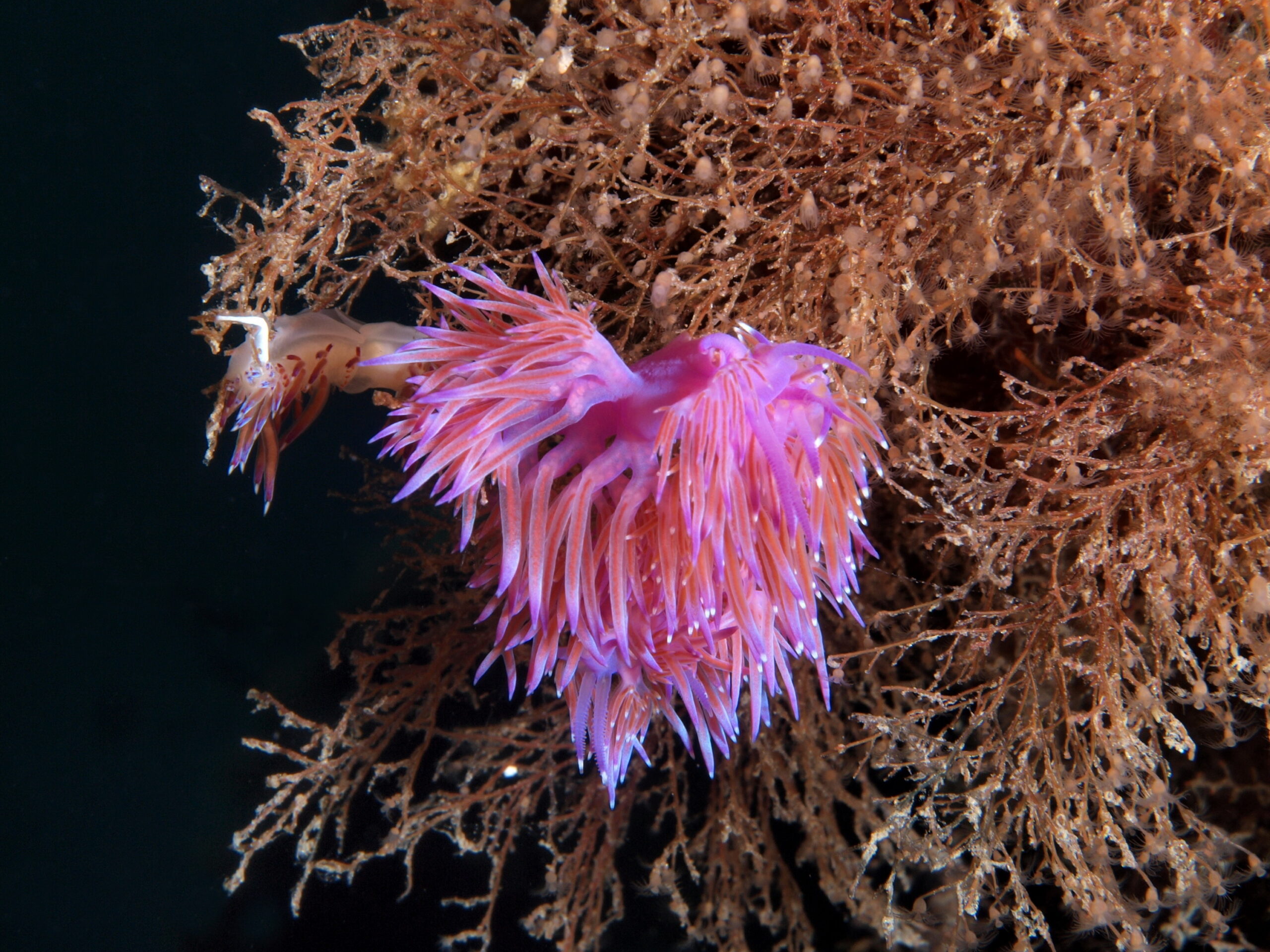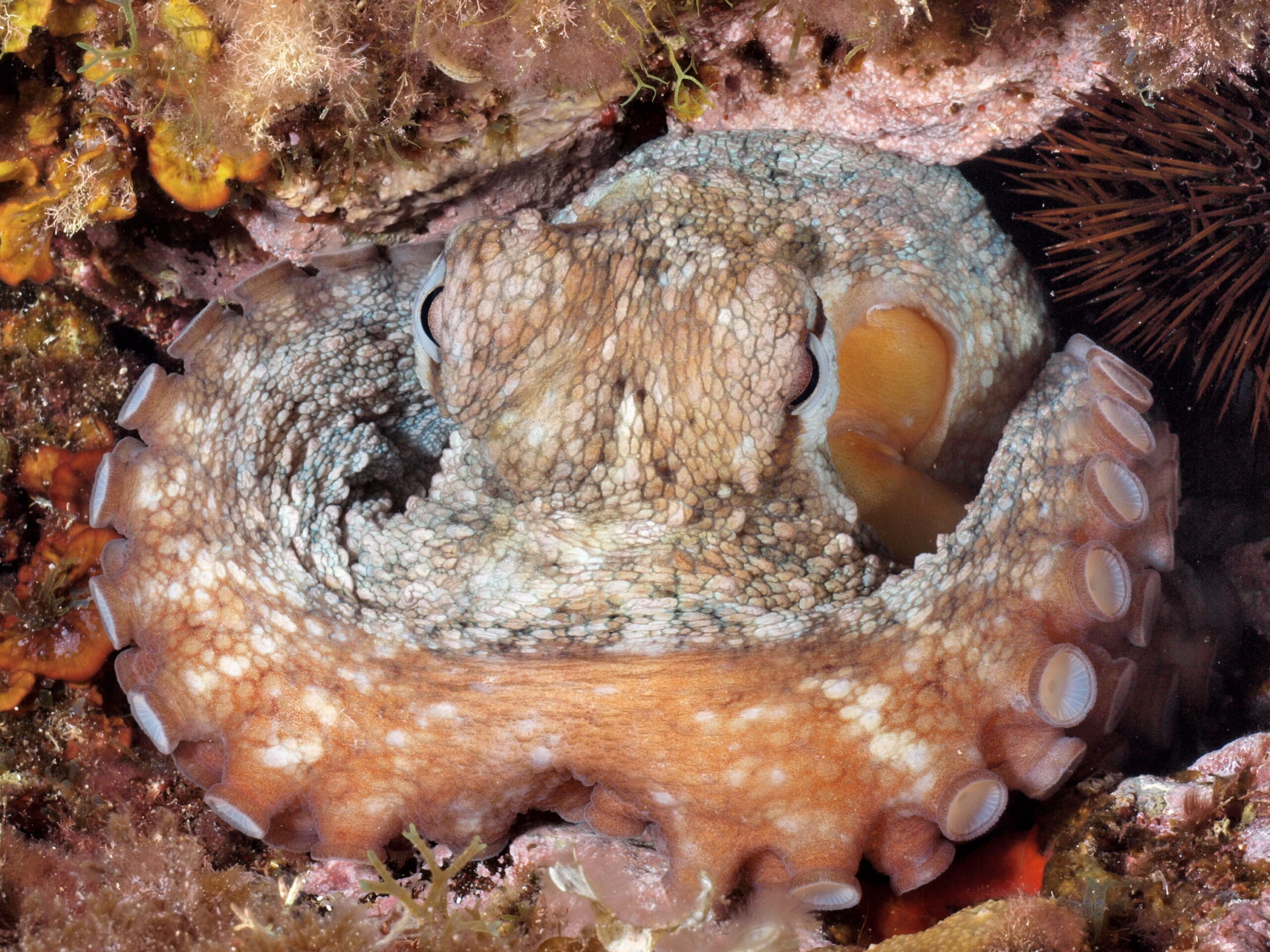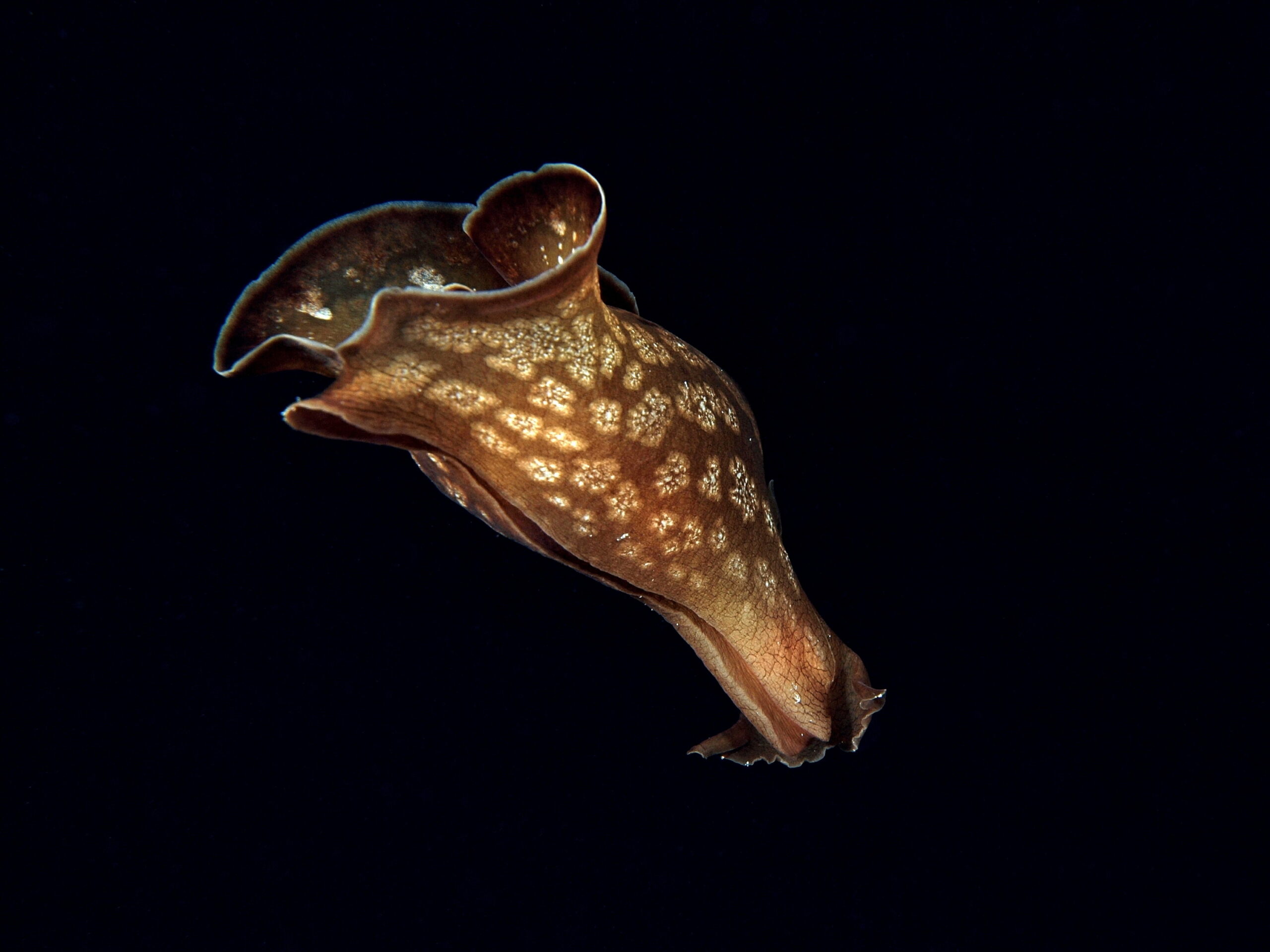Explore the Backdrops of Carloforte
Many unique underwater sites characterized by extraordinary seabeds forming gullies,
pinnacles and fascinating underwater tunnels.
Difficulty: easy; Maximum depth: 18 meters.
This small rock located north of Isola Piana offers a gentle slope down to 18 meters, characterized by large squared boulders. It is a place rich in marine life thanks to the currents present: here it is possible to encounter numerous shoals of bream and damselfish, as well as burrowing fish. Bass and amberjack can occasionally be spotted.
Level: easy; Maximum depth: 18 meters.
This area is characterized by square boulders of volcanic rock that extend from a few meters to about 17-18 meters deep. Between the boulders are numerous crevices and ravines that provide shelter for various burrowing fish.
Level: easy; Maximum depth: 20 meters.
The dive begins with a broad boulder-strewn descent from about 8-10 meters down to the sand at a depth of 20 meters. After that, it continues on a seemingly uniform plateau, which is actually full of passages and rifts where groupers, croakers, cicadas, bream and barracuda can be found.
Level: easy; Maximum depth: 20 meters.
We anchor inside an attractive semi-emersed cave on a seabed characterized by large boulders. We begin by heading outside the cave, where the rocky outline forms almost a canyon that descends rapidly to a maximum depth of 20 meters. Next, we head back inside the cave, where it is easy to spot the typical fauna of these environments: croakers, conger eels, shrimps and more. The play of light inside the cave is particularly striking.
Level: easy; Maximum depth: 20 meters.
Immediately after Goose Point, there is a small, semi-emersed cave that creeps several meters into the cliff, ending with a small rock column around which you can turn to go back. The spectacular light effects and atmosphere create a unique experience, while it is possible to spot the typical fauna of dimly lit environments, including numerous clouds of small shrimp and especially many cypress.
Level: medium; Maximum depth: 22 meters.
This cave extends for about 20 meters on a plateau that slopes gently from about 17 meters down to a depth of 22 meters. Varied fauna fond of dark environments can be found here, including mustels, conger eels and cicadas, and sometimes even some lobsters.
Level: easy; Maximum depth: 19 meters.
A few meters down begins a narrow gully that slopes down to 18-20 meters. Sand and crushed boulders alternate on the bottom, providing an interesting habitat for marine microfauna.
Level: difficult; Maximum depth: 40 meters.
This shoal starts at a depth of 25 meters and extends to 38-40 meters. The upper part has several rifts inhabited by moray eels, groupers and numerous spirographs. At greater depths, small craters open up where it is possible to spot lobsters, large conger eels and small branches of red coral.
Level: easy; Maximum depth: 19 meters.
The dive along the coast offers a wall that slopes fairly rapidly. Particularly interesting are the numerous clefts in the rock, which serve as shelter for groupers, bream and moray eels.
 Level: difficult; Maximum depth: 40 meters.
Level: difficult; Maximum depth: 40 meters.
The dive takes place on a shoal located about 19-20 meters deep, immediately north of the striking Cape Sandalwood lighthouse. Continuing northward, the rock face has a sudden slope that leads down to the sand at a depth of about 40 meters. It is interesting to note the presence of microfauna in this area.
Level: medium; Maximum depth: 40 meters.
In this dive along the walls of a volcanic rock cliff, you descend from a few meters down to about 38-40 meters on the sand. Continuing along one of the many gullies parallel to the emerged rock, you encounter a series of large boulders that create fun passages. The presence of current can make the dive challenging at times, but this also guarantees the presence of many species of fish, both burrowing and passing, making for a sensational experience! The microfauna is remarkable, with beautiful walls of parazoanthus and brightly colored sponges, making this a great place for both environmental and macro underwater photography.
Level: easy; Maximum depth: 25 meters.
You dive over a small shoal at a depth of 5 meters, located south of the Horn Rock. Continuing south, a long, narrow canyon is awe-inspiring. The current, which is often present, gives a solid dynamism for the dive, making it very interesting. In this setting, it is common to encounter immense shoals of bream, bream, and grouper.
Level: difficult; Maximum depth: 33 meters.
This beautiful cave, located south of Scoglio del Corno and facing a pancake whose highest point is at about 19-20 meters, offers a challenging but rewarding dive. You anchor on the summit and continue into the cave to a maximum depth of 33 meters. The cave is extremely large, although it has some somewhat low-roofed passages that require excellent buoyancy control to avoid bumping into the protruding red coral sprigs. Inside the cave, in addition to red coral, it is possible to encounter lobsters, large scorpionfish and mustels.
Level: Intermediate; Maximum depth: 36 meters
This plateau features a vertical slope towards the north that descends from a depth of about 17-18 meters to 35-36 meters on the sand. Along the wall are exciting cracks inhabited by conger eels and lobsters, while on the upper levels, the numerous crevices often hide groupers and sizable breams.
Level: difficult; Maximum depth: 36 meters.
A series of rocky pinnacles, extending from about 17 to 36 meters deep, create a striking and fascinating environment. This rock formation is populated by a variety of burrowing fish, including conger eels, moray eels, groupers and the occasional lobster.
Level: Easy; Maximum depth: 25 meters
The dive along the wall of the namesake point, which slopes down to the sand at about 25 meters deep, is characterized by various rocky masses and cliffs that open into small inlets along the way. Here, you can observe an exciting microfauna that populates the marine environment.
Level: Easy; Maximum depth: 13 meters
The beautiful cliffs of Mezzaluna Cove extend underwater, maintaining deep cracks channeling into the rock, creating impressive caves and tunnels. During the dive, you follow a path through these crevices, each unique, stimulating the diver's imagination and curiosity. The typical flora and fauna of low-light habitats are present in this environment.
Level: Easy; Maximum depth: 18 meters
The rocky formation of the namesake location above water continues below the surface, offering divers a rocky profile characterized by cliffs that create channels rich in interesting microfauna and flora.
Level: Easy; Maximum depth: 20 meters
Like wide columns, close to the namesake "Columns" that emerge above water, the nearly submerged rocks rapidly descend to 18-20 meters, creating fun channels and passages for divers. There are notable colonies of nudibranchs and interesting microfauna, making it ideal for macro photography.
Level: Very Easy; Maximum depth: 9 meters
Here, the rock slopes down onto the sand, creating an ideal environment for our training dives.
Level: Very Easy; Maximum depth: 8 meters
Just south of the Carloforte marina, between the sand and the seagrass, lies the wreck of a hydrofoil that sank years ago due to a fire. At a depth of about 8 meters, this wreck is a habitat for various fish species that vary with the seasons. This site is particularly suitable for training dives.
Level: Intermediate; Maximum depth: 38 meters
This is an extensive shoal located west of the Mangiabarche lighthouse, near the island of Sant'Antioco. We anchor on the edge of the western drop-off at a depth of about 19-20 meters, and heading southwest, we quickly descend to 38 meters on a very fine and light sediment. Here you will find large yellow sponges (Axinella Cannabina) and crown sea urchins. The shoal is covered by a layer of light silt, creating an almost lunar atmosphere, but it hides fascinating benthic life. Of particular interest is a Roman anchor stock about three meters long. This site is suitable for intermediate-level divers.
Level: Difficult; Maximum depth: 45 meters
Description: This is an isolated shoal located about 1 mile from the coast, with the highest point of the peak at 13 meters, descending vertically to a depth of 45 meters. This spot is extremely rich in marine life due to the frequent presence of currents. You can observe large groupers, lobsters, breams, moray eels, and clouds of red damselfish. The microfauna present at the top is equally interesting. Due to the depth and currents, this dive is recommended only for experienced divers.
Level: Intermediate; Maximum depth: 45 meters
This large and impressive volcanic rock formation offers an underwater landscape that descends steeply to 50 meters deep. The flora and fauna here indicate strong hydrodynamic currents, creating unique situations not found elsewhere. You will find an extensive colony of sargassum and odorous algae (Dictyopteris membranacea), evidence of these currents. During the dive, you may encounter various pelagic species, such as schools of amberjack and bonito, depending on the season. This dive is recommended for intermediate divers due to the depth and currents present.
Discover the hidden beauty beneath the sea's surface
A wealth of marine fauna and flora characterizes these unique seabeds, making every dive an unforgettable experience




